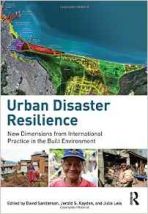Urban Disaster Resilience: New Dimensions from International Practice in the Built Environment

Stemming from the Design for Urban Disaster conference at Harvard University in 2014, Urban Disaster Resilience explores the concepts of “urban” and “disaster” within the framework of “resilience”. Across three sections, the book specifically looks at: Urban planning, design and cities; People, places, complex systems and regulation; and Urban markets, micro-enterprise, insurance and technology.
To start, David Sanderson illustrates the importance of a resilience perspective. He then outlines what is included in this aspirational paradigm, and concludes by considering the relevance of urban disaster resilience for humanitarian practice. Jerold S Kayden focuses on strengthening collaboration in urban disasters, identifying how the book speaks to both humanitarians and urban planners and designers, and details why these two distinct professional groups should collaborate to a greater degree both pre- and post-disaster events.
Part 1 looks at urban planning, design and cities, and Chapter 1 commences by discussing designing resilient cities and neighbourhoods. After presenting the definition and characteristics of a resilient city grounded in planning and urban design concepts, it goes on to introduce a methodology for future visioning and back-casting aimed to facilitate city retrofitting. Chapter 2 then explores what benefits urban planning and design practices offer to post-disaster recovery efforts, namely through humanitarian action, to facilitate more developmental approaches. It also identifies the tensions between urban planning/design and humanitarian approaches and highlights the importance of how we conceive the city. Chapter 3 analyses the recovery process following Chile’s earthquake and tsunami in 2010, and identifies seven lessons from the Ministry of Housing and Urban Planning’s housing and urban recovery programmes. To conclude Part 1, Chapter 4 explores the concept and potential of resilience building in fragile cities within conflict-affected countries that have heightened vulnerability to disasters and violence (page 77).
Part 2 turns to people, places, complex systems and regulation. To start, Chapter 5 looks at Bangkok’s 2011 flood and uses a morphological and complex adaptive systems approach to resilience in order to draw lessons about urban disaster resilience building among low-income neighbourhoods. It argues this approach puts people at the centre of resilience and also highlights how the built form interacts with three complex adaptive systems: economic, governance, and social (page 100). Chapter 6 discusses Tacloban in the Philippines to explore the housing, land and property (HLP) issues that developed in the response to Typhoon Haiyan in 2013. Here the authors identify four key points to help integrate HLP into the recovery process. Following on, Chapter 7 explores how post-disaster reconstruction affects long-term resilience based upon case study research in 10 developing nations with reconstruction going back between 4 and 35 years (page 121). Specifically, it asks how urban housing and the urban poor can be made more resilient, and also what the implications of resilience are for urban reconstruction. Chapter 8 concludes Part 2 by emphasising the importance of building resilient place identity through planning and urban design during a post-conflict recovery process (page 132). In particular it assesses the impact of Kurdish place identity in Erbil, Iraq, which has experienced two key spatial changes – displacement and reconstruction – following Iraq’s conflict and political instability.
Part 3 finally discusses urban markets, micro-enterprise, insurance and technology. Chapter 9 draws upon two case studies of post-disaster response in Haiti and the Philippines to assess the benefits of using market-sensitive and market-supportive interventions in response and recovery programming (page 149). It emphasises the need to include market analysis throughout humanitarian aid projects. Chapter 10 then offers four main lessons from the positive reconstruction process of the Iron Market in Haiti following the devastating earthquake of 2010. It illustrates how a private sector company, the phone company Digicel, played a powerful role in the reconstruction process, and highlights the social and economic ramifications of this. Chapter 11 considers how disaster insurance schemes may be used to build urban resilience. It specifically examines the All India Disaster Mitigation Institute’s Afat Vimo programme, which links to recovery and disaster preparedness and offers micro-insurance to small urban enterprises (pages 175 to 179). To end, Chapter 12 evaluates “humanitarian hybrids”, in order words practices that are infused with new technologies and emerge from the convergence of scientific and humanitarian practices (page 189).
The book concludes with an epilogue by Julia Leis. In this, Leis reviews resilience at the city level and considers the challenges that disaster risk reduction faces, especially in relation to participation, markets and local economies, scenario planning, and technology.
Search the Book notes database
Our Book notes database contains details and summaries of all the publications included in Book notes since 1993 - with details on how to obtain/download.
Use the search form above, or visit the Book notes landing page for more options and latest content.
For a searchable database for papers in Environment and Urbanization, go to http://eau.sagepub.com/

